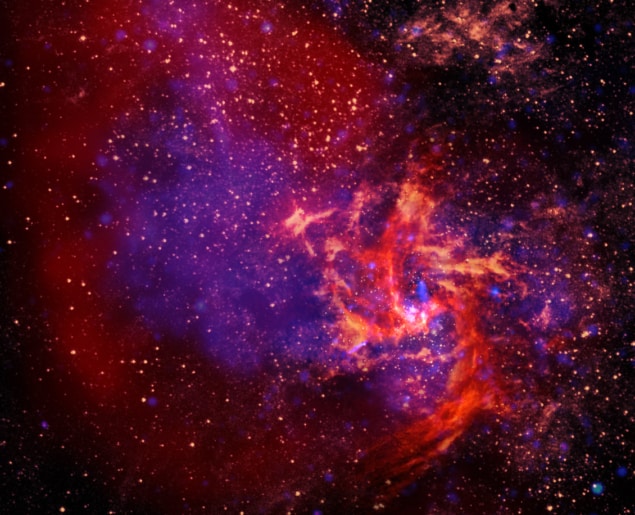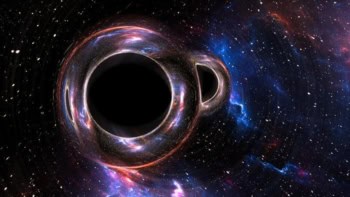Sidney Perkowitz on attempts to measure the fine structure constant α near black holes

Black holes remain a fascinating idea in popular physics while inspiring high-level research. Indeed, the 2020 Nobel Prize for Physics honoured theoretical work on black holes carried out by Roger Penrose and observational results obtained by Andrea Ghez and Reinhard Genzel. In the 1990s, both Ghez and Genzel independently analysed the motion of stars near our galactic centre, some 27,000 light-years away from Earth. They concluded that a supermassive black hole (SMBH) resides there and holds 4 million times the mass of our Sun. Apart from finding unambiguous evidence of its existence, the discovery carries a bonus – the black hole’s extreme gravitational effects provide a new way for physicists to explore α, the fine structure constant.
Physical theories rely on essential constants such as c, e, ħ and the gravitational constant G, but some physicists argue that unitless constants are more fundamental because they are invariant in any system of measurement. The fine structure constant α – defined as e2/(4πε0ħc) where ε0 is the permittivity of free space – is one such pure number, equal to 0.0072973525693. It appeared in 1916 when Arnold Sommerfeld added relativity to quantum mechanics and calculated a better agreement with the observed fine features of the hydrogen spectrum. α showed up again in the 1920s in Paul Dirac’s relativistic quantum ideas, and in astronomer Arthur Eddington’s theory of the universe. Eddington predicted that 1/α would be an integer but failed to make a convincing case (the latest value 137.036 is only nearly a whole number).
Instead, α acquired deeper meaning within quantum electrodynamics (QED), the theory that won Richard Feynman and two others a Nobel prize in 1965. Now α is understood as determining how strongly electrons and photons couple. It is a key to the electromagnetic force, which – along with gravity, and the strong and weak nuclear forces – controls the universe. Within multiverse models proposing that our particular universe is especially tuned to support life, α may be additionally significant because a small change in its value would affect the conditions for life to form.
Within multiverse models proposing that our particular universe is especially tuned to support life, α may be additionally significant because a small change in its value would affect the conditions for life to form
In 1937 Dirac asked if the “constants” are really constant when he speculated that α and G have changed as the universe has aged. Such changes in the constants of nature could alter the Standard Model of particle physics, and general relativity, as well as modify our understanding of the history of the universe. Following Dirac’s suggestion, various researchers have searched for changes in the constants, especially c and α.
Since 1999 astrophysicist John Webb at the University of New South Wales, Australia, has sought changes in α over cosmic time. He examined light from astronomically distant sources after it traversed interstellar dust clouds, which imprints on the light spectral absorption lines from the atoms in the clouds. Analysing these wavelengths gives the value of α at the remote location and therefore in a younger universe, as determined by the time lag due to the finite speed of light. Webb’s early data showed an extremely small increase over the last 6 billion years. But in 2020 he interpreted new results from 13 billion years ago, when the universe was only 0.8 billion years old, as “consistent with no temporal change”. Webb however obtained a bigger change, 4 × 10–5 relative to the value on Earth, in measurements made in the strong gravity around a white dwarf star.
There are theoretical reasons why α should depend on gravity. Also last year, general relativity theorist Aurélien Hees of the Paris Observatory, along with 13 international co-authors including Ghez, used her data to measure the effect of the black hole’s gravity on α (Phys. Rev. Lett. 124 081101).
This is the first measurement of α near an SMBH, and the work shows that this approach can more fully examine the connection between α and gravity. Ghez established the presence of the SMBH by plotting the observed paths of stars that orbit the galactic centre. These paths occurred within the gravitational field from the presumed black hole but were distant enough to form ellipses according to Newtonian mechanics; general relativity was not required. Then a comparatively straightforward analysis yielded the value of 4 million solar masses at an elliptical focus that held the stars in orbit.
To measure α at high gravity, the researchers chose five stars that came near the SMBH, and also have stellar atmospheres with strong spectral absorption lines. Then wavelength analysis gave the value of α at those locales, with small measured deviations of 1 × 10–5 or less from the Earthly value. Still, the data already yield new insight by supporting the prediction that the change in α is proportional to the gravitational potential. However, the measurement uncertainties are too large to yield a definitive value for the proportionality constant, which according to Hees et al. would help distinguish among different theories that incorporate dark matter and dark energy.
Hees now wants to observe stars that are closer to the black hole as they experienced a stronger gravitational potential. The spectral analysis will be harder, but Hees reckons he can reduce the measurement errors 10-fold and has requested new telescope time to do so. We should be optimistic that further improvement will bring new knowledge about α and the universe.



